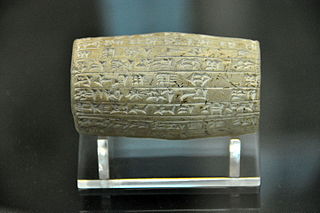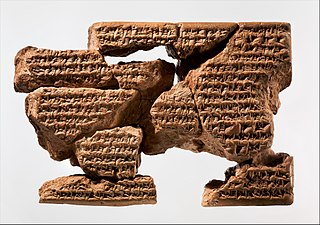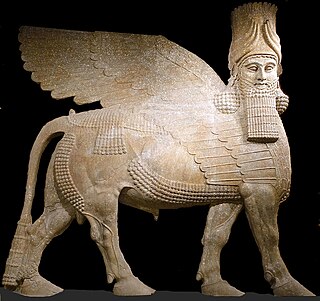
Chaldea was a small country that existed between the late 10th or early 9th and mid-6th centuries BC, after which the country and its people were absorbed and assimilated into the indigenous population of Babylonia. Semitic-speaking, it was located in the marshy land of the far southeastern corner of Mesopotamia and briefly came to rule Babylon. The Hebrew Bible uses the term כשדים (Kaśdim) and this is translated as Chaldaeans in the Greek Old Testament, although there is some dispute as to whether Kasdim in fact means Chaldean or refers to the south Mesopotamian Kaldu.

Sennacherib was the king of the Neo-Assyrian Empire from the death of his father Sargon II in 705 BC to his own death in 681 BC. The second king of the Sargonid dynasty, Sennacherib is one of the most famous Assyrian kings for the role he plays in the Hebrew Bible, which describes his campaign in the Levant. Other events of his reign include his destruction of the city of Babylon in 689 BC and his renovation and expansion of the last great Assyrian capital, Nineveh.

The 7th century BC began the first day of 700 BC and ended the last day of 601 BC.

Babylonia was an ancient Akkadian-speaking state and cultural area based in central-southern Mesopotamia and parts of Syria. A small Amorite-ruled state emerged in 1894 BC, which contained the minor administrative town of Babylon. It was a small provincial town during the Akkadian Empire but greatly expanded during the reign of Hammurabi in the first half of the 18th century BC and became a major capital city. During the reign of Hammurabi and afterwards, Babylonia was called "the country of Akkad", a deliberate archaism in reference to the previous glory of the Akkadian Empire.

Esarhaddon, also spelled Essarhaddon, Assarhaddon and Ashurhaddon was the king of the Neo-Assyrian Empire from the death of his father Sennacherib in 681 BC to his own death in 669. The third king of the Sargonid dynasty, Esarhaddon is most famous for his conquest of Egypt in 671 BC, which made his empire the largest the world had ever seen, and for his reconstruction of Babylon, which had been destroyed by his father.

Nabopolassar was the founder and first king of the Neo-Babylonian Empire, ruling from his coronation as king of Babylon in 626 BC to his death in 605 BC. Though initially only aimed at restoring and securing the independence of Babylonia, Nabopolassar's uprising against the Neo-Assyrian Empire, which had ruled Babylonia for more than a century, eventually led to the complete destruction of the Assyrian Empire and the rise of the Neo-Babylonian Empire in its place.

Sinsharishkun or Sin-shar-ishkun was the penultimate king of Assyria, reigning from the death of his brother and predecessor Ashur-etil-ilani in 627 BC to his own death at the Fall of Nineveh in 612 BC.

Shamash-shum-ukin, was king of Babylon as a vassal of the Neo-Assyrian Empire from 668 BC to his death in 648. Born into the Assyrian royal family, Shamash-shum-ukin was the son of the Neo-Assyrian king Esarhaddon and the elder brother of Esarhaddon's successor Ashurbanipal.
Mushezib-Marduk, Chaldean prince chosen as King of Babylon after Nergal-ushezib.
Ashur-nadin-shumi was a son of the Neo-Assyrian king Sennacherib and was appointed by him as the king of Babylon, ruling southern Mesopotamia from 700 BC to his capture and execution by the Elamites in 694 BC. Ashur-nadin-shumi was probably Sennacherib's firstborn son and his first crown prince and thus the designated successor to the Assyrian throne.

Ellipi was an ancient kingdom located on the western side of the Zagros, between Babylonia at the west, Media at the north east, Mannae at the north and Elam at the south. The inhabitants of Ellipi were close relatives of the Elamites.

The history of the Assyrians encompasses nearly five millennia, covering the history of the ancient Mesopotamian civilization of Assyria, including its territory, culture and people, as well as the later history of the Assyrian people after the fall of the Neo-Assyrian Empire in 609 BC. For purposes of historiography, ancient Assyrian history is often divided by modern researchers, based on political events and gradual changes in language, into the Early Assyrian, Old Assyrian, Middle Assyrian, Neo-Assyrian and post-imperial periods.

The Neo-Assyrian Empire was the fourth and penultimate stage of ancient Assyrian history and the final and greatest phase of Assyria as an independent state. Beginning with the accession of Adad-nirari II in 911 BC, the Neo-Assyrian Empire grew to dominate the ancient Near East throughout much of the 8th and 7th centuries BC, becoming the largest empire in history up to that point. Because of its geopolitical dominance and ideology based in world domination, the Neo-Assyrian Empire is by many researchers regarded to have been the first world empire in history. At its height, the empire was the strongest military power in the world and ruled over all of Mesopotamia, the Levant and Egypt, as well as portions of Anatolia, Arabia and modern-day Iran and Armenia.
The Battle of Halule took place in 691 BC between the Assyrian empire and the rebelling forces of the Babylonians, Chaldeans, Persians, Medes, Elamites and Aramaic tribes.

The Revolt of Babylon in 626 BC refers to the revolt of the general Nabopolassar and his war of independence until he successfully consolidated control of Babylonia in 620 BC, defeating the Neo-Assyrian Empire which had ruled Babylonia for more than a century. The revolt saw the formation of the Neo-Babylonian Empire and was one of the key factors contributing to the fall of Assyria; twenty years after the revolt had begun, Nabopolassar's army and that of his ally, Cyaxares of the Medes, had destroyed the Neo-Assyrian Empire.

The timeline of ancient Assyria can be broken down into three main eras: the Old Assyrian period, Middle Assyrian Empire, and Neo-Assyrian Empire. Modern scholars typically also recognize an Early period preceding the Old Assyrian period and a post-imperial period succeeding the Neo-Assyrian period.

The Sargonid dynasty was the final ruling dynasty of Assyria, ruling as kings of Assyria during the Neo-Assyrian Empire for just over a century from the ascent of Sargon II in 722 BC to the fall of Assyria in 609 BC. Although Assyria would ultimately fall during their rule, the Sargonid dynasty ruled the country during the apex of its power and Sargon II's three immediate successors Sennacherib, Esarhaddon and Ashurbanipal are generally regarded as three of the greatest Assyrian monarchs. Though the dynasty encompasses seven Assyrian kings, two vassal kings in Babylonia and numerous princes and princesses, the term Sargonids is sometimes used solely for Sennacherib, Esarhaddon and Ashurbanipal.

Arda-Mulissu or Arda-Mulissi, also known as Urdu-Mullissi, Urad-Mullissu and Arad-Ninlil and known in Hebrew writings as Adrammelech, was an ancient Assyrian prince of the Sargonid dynasty, the son of Sennacherib, king of the Neo-Assyrian Empire, and the older brother of Sennacherib's successor Esarhaddon. Arda-Mulissu served as Sennacherib's crown prince and heir for ten years, from the time of the death of Sennacherib's first crown prince Ashur-nadin-shumi in 694 BC, but was for unknown reasons replaced as heir by Esarhaddon in 684 BC.

The Assyrian conquest of Egypt covered a relatively short period of the Neo-Assyrian Empire from 677 BCE to 655 BCE.












